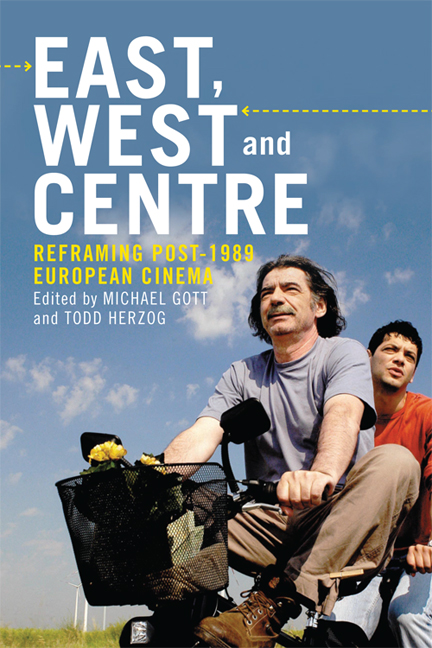Book contents
- Frontmatter
- Contents
- List of Figures
- Notes on Contributors
- Acknowledgements
- Introduction: East, West and Centre: ‘Mapping Post-1989 European Cinema’
- Part I Redrawing the Lines: De/Recentring Europe
- Part II Border Spaces, Eastern Margins and Eastern Markets: Belonging and the Road to/from Europe
- Part III Spectres of the East
- 14 Through the Lens of Black Humour: A Polish Adam in the Post-Wall World
- 15 East Germany Revisited, Reimagined, Repositioned: Representing the GDR in Dominik Graf's Der rote Kakadu (2005) and Christian Petzold's Barbara (2012)
- 16 Barluschke: Towards an East–West Schizo-history
- 17 The Limits of Nostalgia and (Trans)National Cinema in Cum mi-am petrecut sfârşitul lumii (2006)
- 18 The Ideal of Ararat: Friendship, Politics and National Origins in Robert Guédiguian's Le Voyage en Arménie
- Notes
- Bibliography
- Index
16 - Barluschke: Towards an East–West Schizo-history
from Part III - Spectres of the East
Published online by Cambridge University Press: 05 September 2016
- Frontmatter
- Contents
- List of Figures
- Notes on Contributors
- Acknowledgements
- Introduction: East, West and Centre: ‘Mapping Post-1989 European Cinema’
- Part I Redrawing the Lines: De/Recentring Europe
- Part II Border Spaces, Eastern Margins and Eastern Markets: Belonging and the Road to/from Europe
- Part III Spectres of the East
- 14 Through the Lens of Black Humour: A Polish Adam in the Post-Wall World
- 15 East Germany Revisited, Reimagined, Repositioned: Representing the GDR in Dominik Graf's Der rote Kakadu (2005) and Christian Petzold's Barbara (2012)
- 16 Barluschke: Towards an East–West Schizo-history
- 17 The Limits of Nostalgia and (Trans)National Cinema in Cum mi-am petrecut sfârşitul lumii (2006)
- 18 The Ideal of Ararat: Friendship, Politics and National Origins in Robert Guédiguian's Le Voyage en Arménie
- Notes
- Bibliography
- Index
Summary
In 1997, after a five-year respite from film-making at the Berliner Ensemble, Thomas Heise, an East German author and director for theatre and film, now self-employed in the West, makes a film about somebody who is professionally trained in the art of changing sides. Somebody who has learned how to migrate in between, and adapt to, the different geopolitical spaces of the East and the West, as well as how to apply these skills to other situations in life. This somebody, Berthold Barluschke, worked as a secret agent for the East German Ministry for State Security (MfS); lived in Sweden, Spain, Columbia and New York under a West German identity; married a German-Jewish-American physician in the United States; so fully assumed his alias that he listed this West German name, Knut Dammasch, on his daughter's birth announcement; had a romantic relationship with his party functionary; changed sides to work for the West German Federal Intelligence Service; was accused of selling off the assets of the East German National People's Army after reunification; and, in this film, still has difficulties keeping track of who he is and where he is.
Berthold Barluschke first appears in this film when he is leaving. The camera observes Bert and his other self, his reflection in the mirror, as he paces around the living room. He yells out: ‘Danny, come on! Anna … Joanna! Hurry up!’ When Bert leaves the room, the camera doesn't follow him but stays behind to observe the space. With Bert out of the picture, a roll of bubble paper occupies the centre of the frame. There are boxes stuffed with plastic sheeting, artwork around the room that has yet to be packed and, in the reflection of the mirror, a table covered with bottles and glasses. The room is still in use. Bert returns and waits in front of the piano, fidgeting and scratching his beard. Then he finally gives in, striding across the room and out the door for a second time. The camera is left alone to look at the same not-so-empty frame once again. Viewers can hear him in the background: ‘Danny, come on, it costs money when the film is running! And so on … and the time of these people … one should not needlessly waste it.’
- Type
- Chapter
- Information
- East, West and CentreReframing post-1989 European Cinema, pp. 253 - 266Publisher: Edinburgh University PressPrint publication year: 2014



